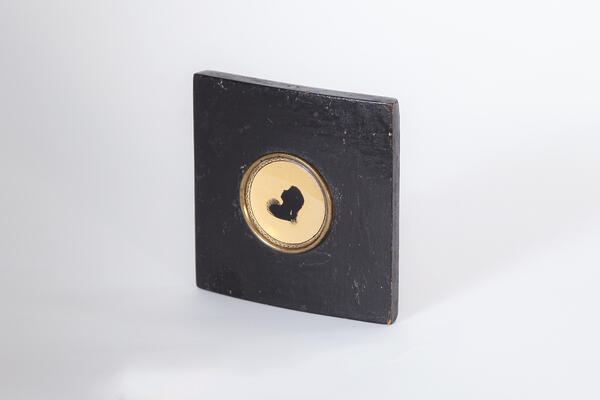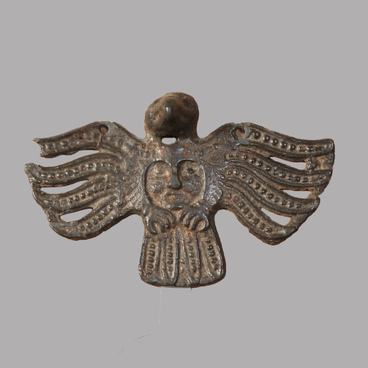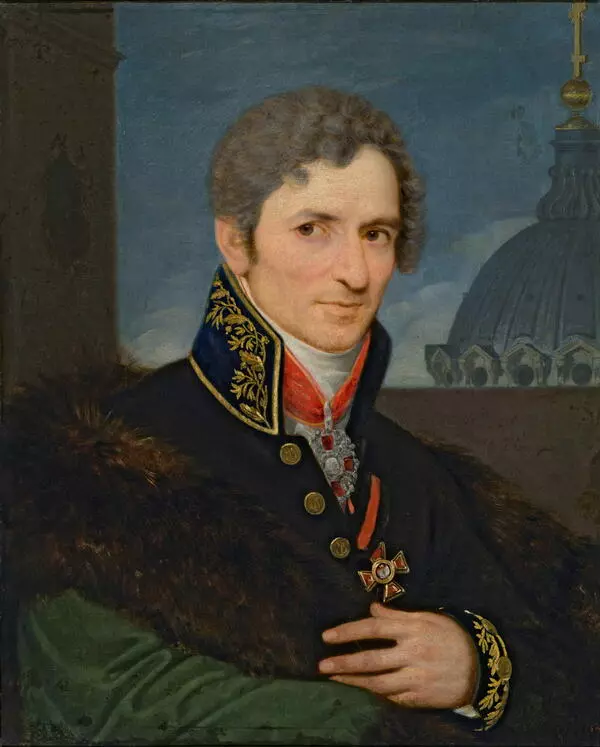The most popular form of fine art in Russia in the 19th century was portraiture. Artists searched for new techniques and means of expression — so the portrait miniature came into vogue. Images were painted in watercolor, gouache, oil and enamel. Ivory was a typical material, but paper, cardboard, metal, porcelain and nacre were also used. A portrait could range in size from 1.5 to 20 centimeters and be in the shape of an oval, rhombus or octagon. Miniatures were inserted into medallions, watches, brooches, snuff boxes and carried along on military campaigns and travels.
An employee of the Leningrad Tourist Bureau assumed that the miniature in the collection of the Komi-Permyak Museum depicts Sophia Alexandrovna Stroganova, the daughter of Count Alexander Stroganov and Catherine Trubetskoy. Her portrait is executed on metal in a yellow round frame, set in a black square board, covered with glass and framed with copper edging. It was donated to the museum in 1928 by the great-great-grandson of the architect Andrey Nikiforovich Voronikhin.
The Russian architect, painter, classicist and founder of the Russian Empire, Andrey Voronikhin was born into a family of peasant serfs in Perm Governorate. The estate’s owner, Count Alexander Stroganov, was the president of the Imperial Academy of Arts and immediately noticed the talent of the boy, an apprentice icon painter. At his own expense, Count Stroganov sent the 17-year-old Andrey to Moscow, where he was trained by the architects Vasily Ivanovich Bazhenov and Matvey Fyodorovich Kazakov.
After completing his education, the young architect was liberated. He moved to St. Petersburg, where he settled in the Stroganov Palace. The Kazan Cathedral and the Mining Institute in St. Petersburg, the Hermitage Cascade in Petrodvorets, and the Rose Pavilion in Pavlovsk were built according to the designs of Andrey Voronikhin. Count Alexander Stroganov helped his foster son to obtain major construction commissions, thereby glorifying his own name upon their successful completion. Andrey Voronikhin worked on the interiors of the Stroganov Palace on Nevsky Prospekt and the Stroganov Dacha in Saint Petersburg. The Komi-Permyak Museum of Local Lore has four miniatures depicting members of the Stroganov family, created by Andrey Nikiforovich Voronikhin.
An employee of the Leningrad Tourist Bureau assumed that the miniature in the collection of the Komi-Permyak Museum depicts Sophia Alexandrovna Stroganova, the daughter of Count Alexander Stroganov and Catherine Trubetskoy. Her portrait is executed on metal in a yellow round frame, set in a black square board, covered with glass and framed with copper edging. It was donated to the museum in 1928 by the great-great-grandson of the architect Andrey Nikiforovich Voronikhin.
The Russian architect, painter, classicist and founder of the Russian Empire, Andrey Voronikhin was born into a family of peasant serfs in Perm Governorate. The estate’s owner, Count Alexander Stroganov, was the president of the Imperial Academy of Arts and immediately noticed the talent of the boy, an apprentice icon painter. At his own expense, Count Stroganov sent the 17-year-old Andrey to Moscow, where he was trained by the architects Vasily Ivanovich Bazhenov and Matvey Fyodorovich Kazakov.
After completing his education, the young architect was liberated. He moved to St. Petersburg, where he settled in the Stroganov Palace. The Kazan Cathedral and the Mining Institute in St. Petersburg, the Hermitage Cascade in Petrodvorets, and the Rose Pavilion in Pavlovsk were built according to the designs of Andrey Voronikhin. Count Alexander Stroganov helped his foster son to obtain major construction commissions, thereby glorifying his own name upon their successful completion. Andrey Voronikhin worked on the interiors of the Stroganov Palace on Nevsky Prospekt and the Stroganov Dacha in Saint Petersburg. The Komi-Permyak Museum of Local Lore has four miniatures depicting members of the Stroganov family, created by Andrey Nikiforovich Voronikhin.





